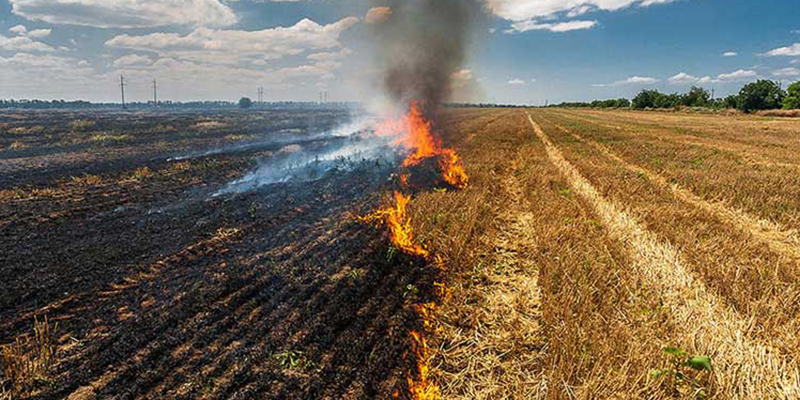Crop residues are parts of the plants that are left behind in the soil after the crop is harvested. There are about 141 million tons of Sulphur crop residues available in India per year, out of which 92 MT is burned each year. Most of the residues in India are generated from Rice and Wheat crops. The residues from the crops like oilseeds, chilli and cotton produce Sulphur residues that are used to make fuel.
Why Do Farmers Burn Residues?
The majority of the farmers burn rice residues in the field, which leads to enormous nutrient losses apart from deteriorating the environment and adversely affecting human health. There are various reasons which enforce residue burning, such as lack of traditional methods, intensive cropping system and combined harvesting.
Furthermore, to ensure the timely sowing of the next crop, farmers need a vacant farm within a short time frame. However, the loose rice straws take time to be managed by mechanical operations; hence, farmers prefer to burn the stubbles. Moreover, paddy residues are hard to chew and have a low calorific value. Their silica content is high; thus, it is not suitable for using animals as fodder.
Some other challenges include:
- Great volume of crop residue.
- Collection and Storage.
- Utilization of crop residue.
- Cost-effective mechanization, awareness and availability of appropriate machinery.
- It takes a long period for the residues to be composed.
Impact of Residue Burnings
Emission of greenhouse gases (GHG)
The burning of crop residues releases a compelling amount of Green House Gases (GHGs). About 70% of carbon dioxide (CO2), 7% of carbon monoxide (CO) and 0.7% of methane (CH4) present in rice straws are emitted in the environment, while 2% N is released as nitrous oxide (N2O) upon burning. This leads to a rise in greenhouse gas emissions.
Nutrient loss
Generally, crop residues contain 80% Nitrogen (N), 25% Phosphorus (P), 50% Sulphur (S) and 20% Potassium (K). The burning of one tonne of crop residue reports for 5.5 Kg Nitrogen, 2.3 Kg phosphorus, 25 Kg potassium and 1.2 kg Sulphur losses while deteriorating organic carbon, polluting environment and increasing greenhouse gas emission leading to climate change. The soil gets enriched in various nutrients if the crop residues are retained in the field itself. Moreover, the food requirement of soil microorganisms and plant nutrients are met.
Impact on soil properties
Some beneficial soil organisms are harmed/killed as the residue burning causes the soil temperature to elevate. The bicarbonate extractable P content is also enhanced due to the burning process. This persistent residue burning results in the complete loss of microbiological organisms. The deterioration of soil caused by the burning of crop residues majorly causes a reduction in the yield of the next crop.
How Can We Manage the Crop Residues
In-situ incorporation
- Crop residue’s in-situ incorporation in soil can be managed by using conventional tillage.
- No-till- The soil is left undisturbed (except from injecting the nutrients) from harvesting to planting of the new crop. Drilling is accomplished in a slot created by coulters, disk openers or roto-tillers.
- Mulch till- The soil is disturbed prior to the planting. Chisels, field cultivators, disks or blades are used as tillage tools.
- Ridge till- The soil is left undisturbed (except from nutrient application) till planting. Planting is done on seedbeds prepared on ridges with disk openers, coulters, or row cleaners. Residues are left on the soil surface between ridges.
- In-situ management of rice residues can also be done through Rotavators.
- Chopper is used for incorporation of the residue in soil, practiced for sowing wheat in Punjab.
In-situ incorporation of crop residues enhances the soil nutrients like N, P, K and SOM. The immobilization of inorganic N is caused by residue incorporation. Straw incorporation with a starter dose of Nitrogen of 15-20 kg per hectare increases the yield of wheat and rice.
Soil mulch
Leaving crop residue in the field as mulch benefits the crop to a great extent. Direct drilling in the surface mulched residues can save time and also conserve nutrients in the soil. In addition, surface retention of crop residues helps in shielding the fertile soil surface against wind and water erosion.
Surface Retention
Machines like Zero tillage and Happy seeders can be used to manage the crop residues. Happy seeder is useful in the combine harvested rice fields for planting the next crop on time and the Zero tillage can be used in standing stubbles of rice which are harvested by combines.
Machines like Zero tillage and Happy seeders can be used to manage the crop residues. Happy seeder is useful in the combined harvested rice fields for planting the next crop on time, and the Zero tillage can be used in standing stubbles of rice that are harvested by combines.
The soil physical properties like soil moisture, humidity and temperature are affected by the residue management practices. Surface retention also acts as mulch and thus plays a vital role in controlling weeds.
Machines like Zero tillage and Happy seeders can be used to manage the crop residues. Happy seeder is useful in the combine harvested rice fields for planting the next crop on time and the Zero tillage can be used in standing stubbles of rice which are harvested by combines.
The soil physical properties like soil moisture, humidity and temperature are affected by the residue management practices. Surface retention also act as mulch and thus plays a vital role in controlling weeds.
Removal
Removal practices include utilizing the crop residues as animal feed, preparing energy, compost, and lowering the wages of manual harvesting. Cultivate the new crop varieties generating lesser residues.
For more information about Agriculture and Livestock, download Apni Kheti app – Android, iPhone



